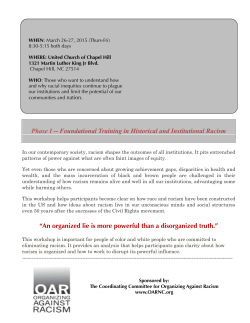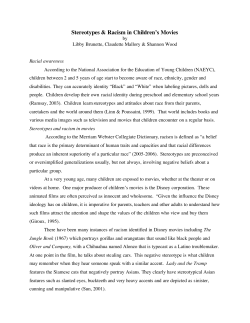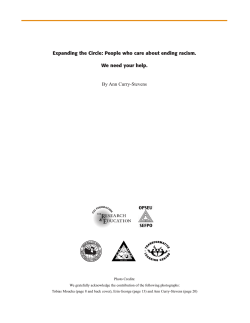
Illumination Project Curriculum Materials
Race and Racism Illumination Project Curriculum Materials By Dr. Rowan Wolf, Sociology Instructor and Caroline Le Guin, Writing Instructor Portland Community College Oregon INTRODUCTION There aren’t too many Americans who want to claim to be racist, and most people would like to believe they are “colorblind” when it comes to matters of race. But race and racism are integral and inescapable parts of our culture and social history. Race consciousness is key to how we learn to perceive ourselves and the people around us (even if we don’t always want to admit it); just think of how we describe people—“an elderly asian woman, about five foot three; a tall black man in his thirties, wearing a leather jacket”. In these “identifying descriptions”, race, along with gender, is essential, especially if it is other than white. Given the importance of race to our society, it’s remarkable how difficult it is to talk about and how complex the definitions of race and racism can be. In fact, the issues surrounding the definitions of race and racism are themselves a product of racism’s long and conflicted history in our society. Any discussion of race and racism probably should begin with definitions of the concepts involved, especially since there tends to be confusion and overlap between a lot of the terms. DEFINITION OF CONCEPTS Race: Race is a socially constructed artifact that categorizes people based on visual differences which are imputed to indicate invisible differences. These categorizations are amorphous and fluid over time which reflects their social rather than physical basis. Its significance arises out of the meanings we as societies assign to it, and the way we structure race in our societies. This structuring shapes what we refer to as "institutional racism" (defined below). The idea that race has a biological basis is an old idea that still hasn’t disappeared entirely and continues to be debated in academia [for a good example see the Nova website at http://www.pbs.org/wgbh/nova/first/race.html for a discussion by anthropologists C. Loring Brace and George W. Gill] Any discussion of the “biology of race”, however, needs to be contextualized within the history of racism as an institution in this country, and an awareness of how our interpretations of race are themselves reflections of our ideologies and our history. Ethnicity: Ethnicity reflects cultural differences, and an ethnic group is a people who share a historical and cultural heritage (and frequently have a sense of group identity). It may or may not 1 overlap with race. However, there is nothing within the concept of a cultural group that excludes that group from being multiracial. For example, members of the U. S. society share a cultural identity. That cultural identity is their ethnicity. Racism: Racism can be defined simply as any policy, belief, attitude, action or inaction, which subordinates individuals or groups based on their race. What this definition leaves out, however, is the specific historical formation of racism as an institution and an ideology over the last several hundred years. Taking into consideration the social and historical perspective, Paula Rothenberg offers this more pointed—and useful--definition of racism: "Racism involves the subordination of people of color by white people. While individual persons of color may well discriminate against a white person or another person of color because of their race, this does not qualify as racism according to our definition because that person of color cannot depend upon all the institutions of society to enforce or extend his or her personal dislike. Nor can he or she call upon the force of history to reflect and enforce that prejudice. . . . History provides us with a long record of white people holding and using power and privilege over people of color to subordinate them, not the reverse." (Paula Rothenberg. Defining Racism and Sexism) Institutionalized racism: Because racism is an ideology that is entwined within the cultural ideology of this society, at some level, everyone who is a cultural member shares many aspects of the ideology of race. That belief system plays out in our day to day interactions with each other whether we are blatantly (or consciously) racist or not. The system of race sets up certain hostilities and conflicts that are played out in our lives. Institutionalized racism is the structuring of benefit for the group with power. Institutionalized processes carry multiple generational effects and are sometimes called "past in present" discrimination. Privilege: The structures of racism work in two ways: to discriminate against and subordinate people of color, and to privilege white people. Privileges are unearned benefits from the structuring of inequality, and as such are intimately tied to discrimination. Privilege (unearned advantages) is sometimes difficult for those receiving them to see. This is particularly true in a societal environment such as the United States, when we think that we get things because we are nice people, or because we worked for them. Molly Ivins once alluded to privilege with the analogy of baseball - a person is born on third base, but thinks they hit a triple. A good introduction to privilege is the 1988 article by Peggy McIntosh White Privilege: Unpacking the Invisible Knapsack , and Allen Johnson's book Privilege, Power, and Difference is more detailed and highly readable. EXAMPLES AND ILLUSTRATIONS Institutionalized Racism: The Housing Market 2 A good example of how institutional racism works is the housing market. The creation of the suburbs in the United States was driven by public policy and tax payer money. The GI Bill through the VHA opened the opportunity to purchase a home to millions of veterans after World War II. However of all the home loans made in those boom years, less than 2% went to non-whites. Meanwhile, the federal government set up lending standards and created "red lining." "Red" districts had low insurability because people of color lived in those areas. White communities were seen as "good risks," and hence lenders did not offer mortgages in red lined districts. These practices excluded people who were not white from the home ownership market. The implication of this one set of policies has had (and still has) massive ramifications. For the majority of people in the United States, their home is their single most important form of wealth. The exclusion of people of color from the housing market meant that only whites had that access to this form of wealth. Getting and owning a home became a "privilege" of being white. Meanwhile, much school funding is still financed through local property taxes. Since people of color were concentrated in areas where they could not own homes (or the homes they owned were devalued) there was less money for schools - degrading educational opportunities. Meanwhile, for whites who had moved "out and up," their schools had more funding and were seen as better schools. Quality of education relates to economic opportunity, and those who were left behind ran even further behind. None of this has anything directly to do with individual bias. Rather it is the consequence of a social policy where whites, acting rationally in their own best interests, participated in increasing levels of inequality between the races. The Power of Race as a Concept: Kennewick Man About ten years ago, a skeleton was uncovered on the banks of the Columbia River in Eastern Washington; the bones were dated to around 7600 B.C.E. Almost immediately, a debate arose over who had “rights” to the bones: the Umatilla, Yakama and Nez Perce tribes who saw the remains as an ancestor who should be left alone and reburied, and members of the scientific community—archeologists and anthropologists--who saw Kennewick Man as a rare find, a subject for study that could reveal significant information about human history. The debate over the cultural and historical meanings of this 9000 year old skeleton reveals the power that the concept of race still wields for us, and how entangled racism is in places we might not expect to find it. While the debate over Kennewick Man can be seen as a conflict of world views and cultural values--Native American faith and traditions up against Western scientific rationalism--closer examination, such as Jack Hitts Harper’s article, “Mighty White of You”, reveals how race and racism permeate the story. To begin with, the Native American claim to the bones is based in the 1990 Native American Graves Repatriation Act, an attempt by the Federal Government to make up for well over a century of mishandling (at best) and desecration (at worst) of Native American remains, often in the name of science and the pursuit of knowledge (Hitts cites an estimate of 200,000 Indian skeletons held in museums). The claims of the scientific community, on the other hand, have relied in part on the identification of Kennewick Man’s remains as not being 3 paleo-Indian (and therefore not an ancestor of the current-day Umatilla and Nez Perce ), but instead being “Caucasoid”. Underneath the scientific debate Hitts identifies a powerful and racially charged motivation: the need to say “We (Europeans) were actually here first; therefore our dominance is justified.” EXERCISES for Classes A lot of exercises around race and racism work with developing an understanding of institutional and internalized racism: how racism is not simply a matter of individual choice. 1. One place to start might be Project Implicit https://implicit.harvard.edu/implicit/demo/ This is a series of association tests which are completed online. They are intended to show unconscious preferences across a variety of status categories. 2. Another area for thought and discussion is to consider how your particular discipline constructs and has historically constructed race: How do other disciplines construct and interpret race differently (how does biology construct race differently from anthropology and psychology differently from literature?) How has the construction of race has been a site of conflict and definition for your discipline as a whole, and what role has your discipline played in both perpetuating and deconstructing racial/ethnic stereotypes? How does exploring the construction of race within your discipline help students to understand that discipline’s particular discourse and world view? An example from the study of folklore: Looking at Joel Chandler Harris’ “Uncle Remus” stories as a site of cultural and ethnic conflict where issues of racial identity and appropriation are illustrated in textual history of the stories: a white journalist writing “authentic” black oral folk stories, many of which turn out to be Native American in origin. 3. Write about the first experience you remember in which you became aware of your race or ethnicity as something that distinguishes you or marks you somehow. 4. Write a dialog between two different voices: 4 Voice One is the bigot or racist, the one that has unconsciously (or consciously) picked up and absorbed all the many stereotypes about different racial/ethnic groups that we are bombarded with. Let this voice spew out all the stereotypes it knows about certain ethnic groups. You don’t have to believe these ideas, you may well find them offensive, or be ashamed to even have them in your head. Part of the point of the exercise is to understand that we absorb these ideas even if we do not consciously believe in them Voice two is the voice of conscience and reason, the voice that knows “stereotyping and bigotry is wrong.” Let this voice challenge and question the assumptions and conclusions of Voice One. (You do not have to share what you wrote or turn it in) When you are done, write a reflection on these two voices. Where do they come from? Where, or from whom did you learn the ideas each voice articulated? Which voice was easier to give voice to, and why? Use your reflection to discuss how stereotypes are learned and unlearned 5. Work in small groups to write definitions for the following terms: Prejudice Bias Discrimination Stereotyping Ethnocentrism Insensitivity Inequality Injustice Indifference Ignorance 5 How does each of these terms differ in denotation and connotation from “racism”? Think about the scenarios depicted in the play, and discuss which of these terms seem best to apply and help make sense of what happened. ________________________________________________________________________ RESOURCES Many of these resources are adapted from the Bedford/St. Martin’s reference Website: www.bedfordstmartins.com/rereadingamerica Allen Johnson on White Privilege http://www.csuchico.edu/pub/inside/archive/02_02_28/allen_johnson.html Digital History: Mexican American Voices http://www.digitalhistory.uh.edu/mexican_voices/mexican_voices.cfm Sponsored by the University of Houston, this site includes texts by Mexican Americans and others writing about Mexican Americans. Contemporary texts are included at the bottom of the page. Eric Lui, “Notes of a Native Speaker” “I never asked to be white. I am not literally white…But like so many other Asian Americans of the second generation, I find myself now the bearer of a strange new status: white, but acclamation.” Ethnic Studies http://207.44.246.88/cgibin/netoh/page.cgi?g=Science%2FSocial_Sciences%2FEthnic_Studies%2Findex.html&d=1 The Internet Open Highway Project presents this directory of links to information for ethnic studies, encompassing countries across the globe. Exploring the Japanese American Internmenthttp://www.jainternment.org Produced by the National Asian American Telecommunications Association, this site offers video clips about the history and present-day impact of Japanese American internment during World War II. Greenfield Community College—Links to White Privilege: Databases & Internet Site http://www.gcc.mass.edu/library/pathfinders/WPInternet.htm Gregory Jay, “Who Invented White People” http://www.uwm.edu/~gjay/Whiteness/Whitenesstalk.html A talk on the occasion of Martin Luther King Jr. Day, 1998 History of Race in Science http://www.racesci.org/ This informative site is sponsored by the Program in Science, Technology & Society at the Massachusetts Institute of Technology. It includes 6 a comprehensive bibliography; links to recent articles in the media on race and science; and links to sites on health, genetics, eugenics, ethnic study, and racism. Index of Native American Electronic Text Resources on the Internet http://www.hanksville.org/NAresources/indices/NAetext.html Part of the WWW Virtual Library, this index includes images, speeches, articles, and other Native American-related resources Jack Hitts, “Mighty White of You: Racial Preferences color America’s oldest skull and bones” Harpers Magazine, July 2005 “The story of the Ancient European One is this kind of story, toggling back and forth between the world of fiction and (possibly) non-fiction, authored by a few curious facts and the collective anxiety of the majority” Martin Luther King, Jr. “Racism and the White Backlash” Naomi Shihab Nye, “To Any Would-Be Terrorists” http://www.arches.uga.edu/~godlas/shihabnye.html “Because I feel a little closer to you than many Americans could possibly feel, or ever want to feel, I insist that you listen to me.. . .I am humble in my country’s pain, and I am furious.” Native Americans http://www.americanwest.com/pages/indians.htm This site includes information on leaders of the past, organizations and government sources for Native Americans, photographs and images from the past, and links to other useful Native American sites. Nova: The Mystery of the First Americans http://www.pbs.org/wgbh/nova/first/race.html On Raising Bilingual and Multilingual Children http://www.imdiversity.com/villages/asian/Article_Detail.asp?Article_ID=2404 This page, part of the Asian-American Village page of IMDiversity.com, gives thorough information on raising bilingual children, as well as a list of related readings and resources The Other Race Card: Rush Limbaugh and the Politics of White Resentment By Tim Wise http://www.counterpunch.org/wise10032003.html Article on Rush Limbaugh's comments Paul L. Wachtel, “Talking About Racism: How Our Dialogue Gets Short-Circuited” “The real crime of which white America is now most guilty is not racism. It is indifference. Understanding the difference between the two is a crucial step in liberating ourselves from the sterile and unproductive impasse that has characterized the dialogue on race relations in recent years. 7 Reginald McKnight, “Confessions of a Wannabe Negro” I can’t say when I first noticed my blackness…I do, however, remember the very day I noticed that my blackness made me different. Racial Bias from Another Perspective: Limbaugh, the United States and South Africa By Heather Gray http://www.commondreams.org/scriptfiles/views03/1006-09.htm Article on Rush Limbaugh's comments Search Latino.com http://www.searchlatino.com Search Latino provides links to sites about Latinos in the arts, technology, education, music, politics, and other fields. Shelby Steele “I’m Black, You’re White, Who’s Innocent? “I think the racial struggle in America has always been primarily a struggle for innocence…Both races instinctively understand that to loose innocence is to lose power. The Arab-American Institute http://www.aaiusa.org/ A rich web site devoted to the ArabAmerican community and the challenges and issues they face in contemporary American society. This web site primarily provides policy and civic research support, but includes a section on publications which contains many articles and essays on Arab/American relations. A link to an educational packet on current discussions in the Arab American community, The Middle East, and Islam, includes many articles from AAI staff writers The Center for the Study of White American Culture http://www.euroamerican.org This site is not a white supremacist site; rather, it is a place for “cultural exploration and selfdiscovery among white Americans.” Click here for a racial awareness quiz, a series of papers on whiteness and its role in a multicultural society, and objectives for creating a society based on multiracial values. The Martin Luther King Jr. Papers Project http://www.stanford.edu/group/king Developed by the King Center for Nonviolent Social Change, this site contains a collection of historical information about Martin Luther King and the civil rights movement, as well as some of King's writings, speeches, and sermons, such as the “I Have a Dream.” The New York Times: “How Race Is Lived in America” http://www.nytimes.com/library/national/race The New York Times won a 2001 Pulitzer Prize for national reporting for its series “How Race Is Lived in America.” This page offers more than a dozen articles on the current state of race relations in many parts of the country. The United Nations Declaration on Race and Racial Prejudice http://www.hri.ca/uninfo/treaties/19.shtml 8 The United Nations declaration against racial prejudice lays out a universal conception of human rights. Viewing Race http://www.viewingrace.org/ The National Video Resources organization was founded by the Rockefeller Foundation in 1990. Their Viewing Race project is a database of independent films, articles, discussion and media resources on the subject of race and diversity to combat racism and promote tolerance. Whites Swim in Racial Privilege By Tim Wise http://www.alternet.org/story/15223/ Discussion of white privilege - particularly in relationship to the U of M affirmative action policies. 9
© Copyright 2025





















